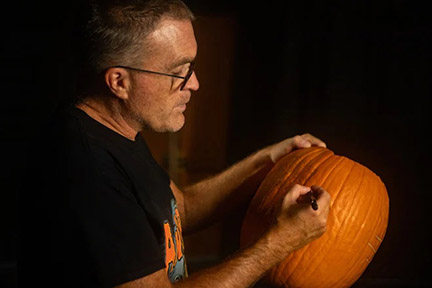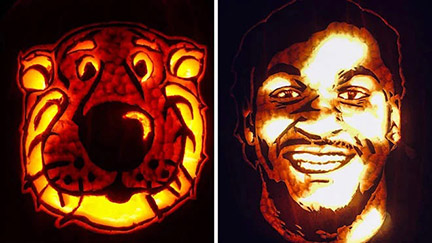COLUMBIA, Mo. — Every October, University of Missouri Professor Mannie Liscum carves exactly 31 jack-o’-lanterns.
https://mailer.umsystem.edu/c/AQjOvBUQ0askGMqQjYYBIKGIqgl8kV2IkEHt5DZjjzwe3YczU3uRFWih_kyxkxI0JOtEFQ
And these aren’t your typical triangle-eyed, buck-toothed pumpkin faces. They’re intricate portraits of movie stars, musicians, family and friends — two-dimensional images that come to life when lit from within.

But for Liscum, a professor of biological sciences in Mizzou’s College of Arts and Science, the tradition is more than just showcasing creative carving skills. It’s a way for him to combine science and art to celebrate the cultural significance of the season’s best-known symbol.
“My research is in plant photobiology, or how plants respond to light,” he said. “But I’m also interested in the historical and cultural aspects of biology and the way science has impacted society. This is a way to bridge those interests.”
A natural passion
Liscum grew up on a dairy farm in a small New England town where everyone celebrated Halloween with lawn decorations, jack-o’-lanterns and lots of trick-or-treaters.

In Columbia, Liscum said he doesn’t get many children asking for candy at his door. About 20 years ago, wanting to find another way to celebrate his favorite holiday, Liscum came across online instructions to carve images onto pumpkins using shading and shaving techniques.
He tested the technique using photos of his children. At first, the carved-up pumpkin portraits didn’t look like much — until he placed a light inside.
“I was shocked at how nice they came out,” he said.
A new passion was born, as carving allowed Liscum to explore the artistic side of his research, playing with light and shadow to bring designs to life.
Since then, Liscum has carved some 450 jack-o’-lanterns. His designs have earned him the nickname “the pumpkin guy” among the heavy metal community as rock stars have recognized and reacted to seeing their faces in his artwork. A couple of years ago, he even carved Mizzou’s Nobel Prize winner — Curators’ Distinguished Professor Emeritus George Smith — and this year showcased Truman and Mizzou Tigers football wide receiver Luther Burden.
But there’s one face you won’t see among his gallery of patterns.
“I won’t carve myself,” he said. “It just seems too vain.”
Ancient origins
Liscum has given a lot of talks on the art of pumpkin carving. More recently, when invited to speak to the MU Interdisciplinary Plant Group, he expanded upon his presentation to provide context around the centuries-old tradition.
Here’s the condensed version:
Long before Halloween as we know it, a Celtic festival marked the end of the harvest season. Early Christians adopted and modified the tradition, known as Samhain, and Nov. 1 became All Hallows’ Day to honor the dead. That made Oct. 31 All Hallows’ Eve.
In those days, there were plenty of stories swirling about spirits among us, including an Irish folktale about Stingy Jack who roamed the earth with a hot coal inside a carved-out turnip. People in Ireland began carving scary faces onto turnips and other vegetables to keep Stingy Jack away from their homes.
When immigrants began to arrive in the New World, they found pumpkins easier to carve as they continued the tradition. Native to the Americas, pumpkins were an important food source at the time.
“The pumpkins we carve today are vastly different from what early settlers found,” Liscum said, noting that today’s jack-o’-lanterns are bred more for looks than taste. “I want people to understand how this canvas we’re using came about, that it arose from native culture and had a different purpose. The pumpkin is a fascinating fruit, becoming an economic staple crop that is mostly ornamental. This is a chance to connect those things.”
The craft of carving
Every year, Liscum sets up a spooky graveyard scene in his yard and hosts a carving party where friends can bring pumpkins, patterns and tools to create their designs. Liscum is there to help gut pumpkins — he can do it in less than a minute—and provide expertise.
But he insists that anyone with a little time and patience can create awe-inspiring jack-o’-lanterns, too.
After decades of carving, Liscum has honed the process to a science and provides tips, tricks and patterns on his website. Here are some key tricks “the pumpkin guy” suggests for creating your own glowing masterpieces this Halloween.
• Find the right pumpkin. Consider the width and height of your design when selecting a pumpkin. For more intricate designs, Liscum recommends finding one with a flatter side.
• When cutting the top off, make the hole large, and don’t cut a perfect circle. This will help keep the lid from falling in as the pumpkin starts to dry.
• While a spoon and knife will work, Liscum suggests purchasing inexpensive carving kits that include a scoop and carving saws.
• Don’t carve complicated designs early if you want to display the jack-o’-lantern on Halloween. Once carved with intricate designs, these pumpkins only last a couple of days before they start to rot.
“And the main thing is to have fun,” Liscum said. “This is a chance to connect with a centuries-old tradition, blending art, science and history with the fun of Halloween.”
